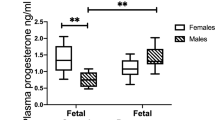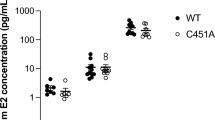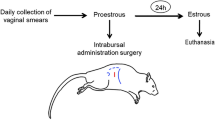Abstract
PROGESTERONE has long been considered an antagonist of oestrogen action1. The delicate balance and interactions between these ovarian hormones are essential for many reproductive functions. Early studies in chick oviducts and uteri of rats and mice have shown that the simultaneous administration of progesterone and oestrogen resulted in inhibition or modification of oestrogen-induced growth of these target organs2–5. One possible mechanism by which progesterone could be antagonistic to oestrogen is by suppressing the quantity of cytoplasmic oestrogen receptor. It is generally held that the mechanism by which oestrogen, O, stimulates uterine growth depends on the binding of O to cytoplasmic receptors, Rc, to form RCO complexes6. These RCO complexes are translocated to nuclear sites where they probably stimulate nuclear events that cause the uterus to grow7. Translocation and nuclear accumulation of receptor–oestrogen complexes, RnO, are accompanied by a concomitant decrease in the quantity of Rc (ref. 8). During the period when Rc is reduced, the uterus is insensitive to additional exogenous oestrogen9. Gradually Rc is replenished by processes which may involve reutilisation and/or resynthesis8. Work from our laboratory indicates that the mechanism of action of non-steroidal oestrogen antagonists resides in their inability to stimulate the replenishment of the cytoplasmic oestrogen receptor, Rc, thereby rendering oestrogen responsive tissues less sensitive to oestrogen10,11. The possibility that progesterone might also act as an oestrogen antagonist by reducing the amount of oestrogen Rc has been suggested12,13. In this report, we demonstrate that progesterone does decrease the quantity of oestrogen receptors by interfering with the replenishment of Rc and that this decrease results in a reduced sensitivity of uterine tissue to oestrogen.
This is a preview of subscription content, access via your institution
Access options
Subscribe to this journal
Receive 51 print issues and online access
$199.00 per year
only $3.90 per issue
Buy this article
- Purchase on Springer Link
- Instant access to full article PDF
Prices may be subject to local taxes which are calculated during checkout
Similar content being viewed by others
References
Lerner, L. J., Rec. Prog. Hormone Res., 20, 435 (1964).
Huggins, C., and Jensen, E. V., J. exp. Med., 102, 347 (1955).
Oka, T., and Schimke, R. T., J. Cell Biol., 43, 123 (1969).
Means, A. R., and O'Malley, B. W., Biochemistry, 10, 2570 (1971).
Bronson, F. H., and Hamilton, T. H., Biol. Reprod., 6, 160 (1972).
O'Malley, B. W., and Means, A. R., Science, 183, 610 (1974).
Clark, J. H., Anderson, J. N., and Peck, E. J., Jr, in Receptors for Reproductive Hormones, Adv. Exp. Med. Biol. (edit. by O'Malley, B. W., and Means, A. R.), 36 (Plenum, New York, 1973).
Gorski, J., Sarff, M., and Clark, J. H. in Advances in the Biosciences (edit. by Raspe, G.), 7 (Pergamon, Vieweg, 1970).
Anderson, J. N., Peck, E. J., Jr, and Clark, J. H., Endocrinology, 95, 174 (1974).
Clark, J. H., Anderson, J. N., and Peck, E. J., Jr, Steroids, 22, 707 (1973).
Clark, J. H., Anderson, J. N., and Peck, E. J., Jr, Nature, 251, 446 (1974).
Leung, B. S., and Sasaki, G. H., Biochem. biophys. Res. Commun., 55, 1180 (1973).
Brenner, R. M., Resko, J. A., and West, N. B., Endocrinology, 95, 1094 (1974).
Williams, D., and Gorski, J., Biochem. biophys. Res. Commun., 45, 258 (1971).
Anderson, J., Clark, J. H., and Peck, E. J., Jr, Biochem. J., 126, 561 (1972).
Katzenellenbogen, J. A., Johnson, H. J., and Carlson, K. E., Biochemistry, 12, 4091 (1973).
Milgrom, E., Thi, L., Atger, M., and Baulieu, E. -E., J. biol. Chem., 248, 6366 (1973).
Leavitt, W., Toft, D. O., Strott, C. A., and O'Malley, B. W., Endocrinology, 94, 1041 (1974).
Brush, M. G., Taylor, R. W., and King, R. J. B., J. Endocr., 39, 599 (1967).
Evans, L. H., and Hahnel, R., J. Endocr., 50, 209 (1971).
Jacobson, H. I., Keyes, P. L., and Bullock, D. W., Biol. Reprod., 7, 108 (1972).
King, R. J. B., and Mainwaring, W. J. P., Steroid Cell Interactions, 190 (University Park Press, Baltimore, 1974).
Jensen, E. V., and DeSombre, E. R., Science, 182, 126 (1973).
Lowry, O. H., Rosebrough, N. J., Farr, A. L., and Randall, R. J., J. biol Chem., 193, 265 (1951).
Ceriotti, G., J. biol. Chem., 198, 297 (1952).
Author information
Authors and Affiliations
Rights and permissions
About this article
Cite this article
HSUEH, A., PECK, E. & CLARK, J. Progesterone antagonism of the oestrogen receptor and oestrogen-induced uterine growth. Nature 254, 337–339 (1975). https://doi.org/10.1038/254337a0
Received:
Revised:
Issue Date:
DOI: https://doi.org/10.1038/254337a0
This article is cited by
-
Preclinical pharmacological profile of nomegestrol acetate, a synthetic 19-nor-progesterone derivative
Reproductive Biology and Endocrinology (2012)
-
Estrogen receptors alpha and beta in rat placenta: detection by RT-PCR, real time PCR and Western blotting
Reproductive Biology and Endocrinology (2006)
-
Medroxyprogesterone acetate and cancer cachexia: Interleukin-6 involvement
Breast Cancer (2000)
-
The distribution of oestrogen and progesterone receptors in the human endometrial basal and functional layer during the normal menstrual cycle
Histochemistry (1993)
-
Double-blind controlled trial of progesterone vaginal cream treatment for cyclical mastodynia in women with benign breast disease
Journal of Endocrinological Investigation (1992)
Comments
By submitting a comment you agree to abide by our Terms and Community Guidelines. If you find something abusive or that does not comply with our terms or guidelines please flag it as inappropriate.



